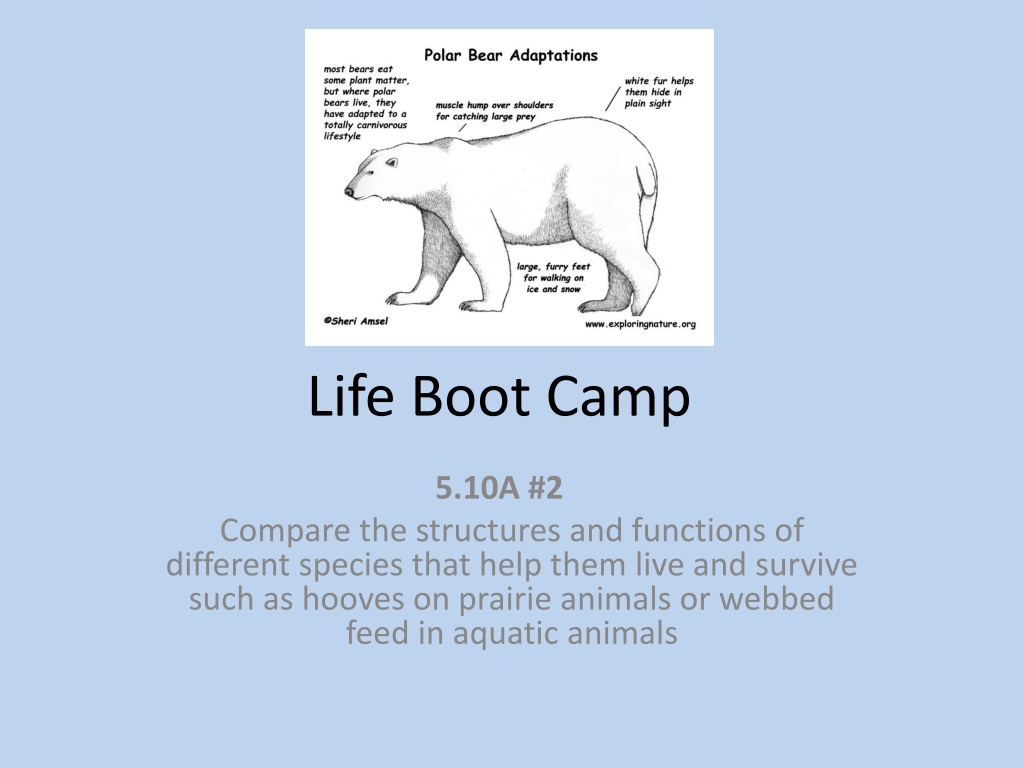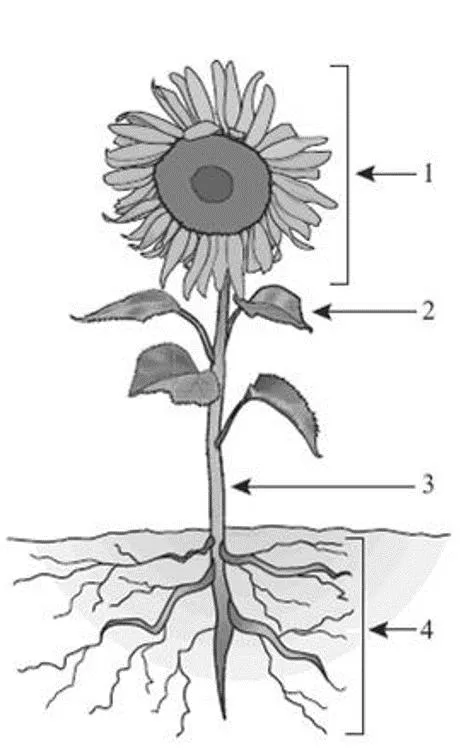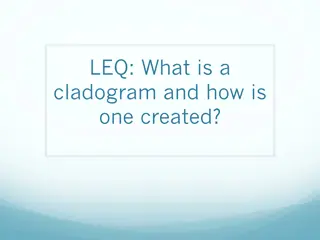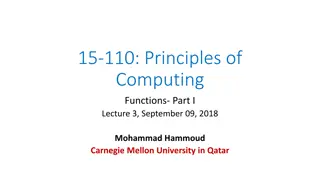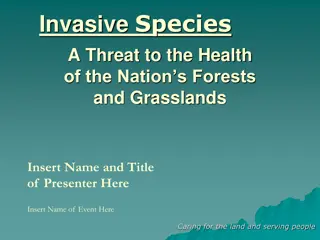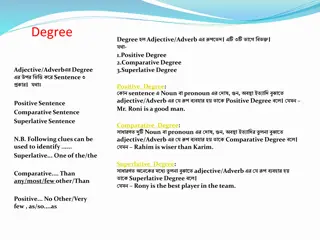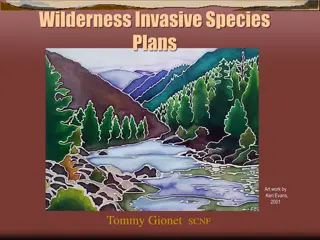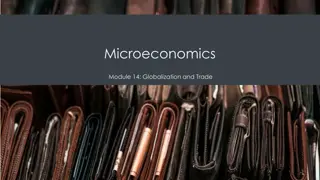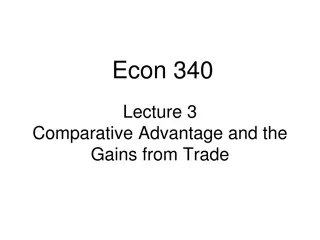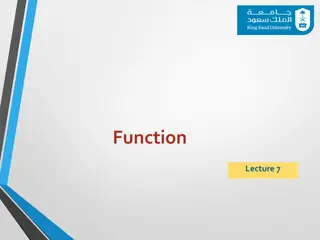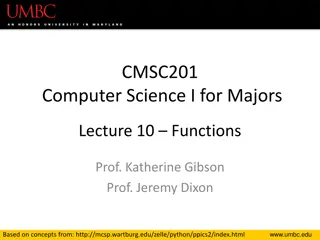Comparative Structures and Functions in Different Species
Explore how various species' physical adaptations, such as hooves and webs, aid in their survival. Understand the key roles of specific plant parts like stems and sunflower sections. Discover how specialized structures in animals like deer and polar bears contribute to their survival strategies.
Download Presentation

Please find below an Image/Link to download the presentation.
The content on the website is provided AS IS for your information and personal use only. It may not be sold, licensed, or shared on other websites without obtaining consent from the author.If you encounter any issues during the download, it is possible that the publisher has removed the file from their server.
You are allowed to download the files provided on this website for personal or commercial use, subject to the condition that they are used lawfully. All files are the property of their respective owners.
The content on the website is provided AS IS for your information and personal use only. It may not be sold, licensed, or shared on other websites without obtaining consent from the author.
E N D
Presentation Transcript
Life Boot Camp 5.10A #2 Compare the structures and functions of different species that help them live and survive such as hooves on prairie animals or webbed feed in aquatic animals
51. Which numbered part of the sunflower is MAINLY responsible for photosynthesis? A Part 1 B Part 2 C Part 3 D Part 4
51. Which numbered part of the sunflower is MAINLY responsible for photosynthesis? A Part 1 B Part 2 C Part 3 D Part 4
52. A plants stem A supports the plant B produces seeds for the plant C anchors the plant in the soil D absorbs water and minerals from the soil
52. A plants stem A supports the plant (holds it up) B produces seeds for the plant C anchors the plant in the soil D absorbs water and minerals from the soil
54. What specialized structures do deer have that help them survive against predators? A Warm, brown hair B Fast running bodies C Good digestive systems D Large and intelligent brains
54. What specialized structures do deer have that help them survive against predators? A Warm, brown hair B Fast running bodies C Good digestive systems D Large and intelligent brains
55. Polar bears have thick, white hair. What advantage does that give the polar bears? A More people will hunt them for their fur. B They look bigger and impress their enemies. C They hunt better and can catch more food. D They stay warmer in very cold climates.
55. Polar bears have thick, white hair. What advantage does that give the polar bears? A More people will hunt them for their fur. B They look bigger and impress their enemies. C They hunt better and can catch more food. D They stay warmer in very cold climates.
56. Which of the following is NOT a way desert animals have adapted to survive in the desert? A Grow long, thick fur B Are active at night C Survive on little water D Live in burrows
56. Which of the following is NOT a way desert animals have adapted to survive in the desert? A Grow long, thick fur B Are active at night C Survive on little water D Live in burrows
57. Animals have adaptations that help them survive. One example of this is the hawk s strong talons. What primary purpose does this adaptation serve? A Protection from predators B Catching and eating food C Increased flying speed D Protection from prey
57. Animals have adaptations that help them survive. One example of this is the hawk s strong talons. What primary purpose does this adaptation serve? A Protection from predators B Catching and eating food C Increased flying speed D Protection from prey
58. Which of the following is an example of an adaptation of an animal s body that would improve its chances of survival in a specific environment? A An armadillo digging a hole under a fence B A chameleon changing colors to hide from a predator C Geese flying in a V formation D A gibbon swinging from branch to branch to escape a predator
58. Which of the following is an example of an adaptation of an animal s body that would improve its chances of survival in a specific environment? A An armadillo digging a hole under a fence B A chameleon changing colors to hide from a predator C Geese flying in a V formation D A gibbon swinging from branch to branch to escape a predator
59. Armadillos and coral snakes both live in Texas. When an armadillo is threatened, it curls its armored body up like a ball. A coral snake curls its tail into a tight spiral and holds it up when an enemy is near. Although these animals are very different, what is one way in which they are similar? A They both live in the water. B They have hard outer coverings. C They have ways to protect themselves. D They attack their enemies with poison.
59. Armadillos and coral snakes both live in Texas. When an armadillo is threatened, it curls its armored body up like a ball. A coral snake curls its tail into a tight spiral and holds it up when an enemy is near. Although these animals are very different, what is one way in which they are similar? A They both live in the water. B They have hard outer coverings. C They have ways to protect themselves. D They attack their enemies with poison.
60. The flowers that grow on the floor of a tropical forest have long stems. How does this adaptation help them survive in their environment? Long stems A protect them from getting too hot B make it easier for them to get sunlight C prevent them from being eaten D make it easier to pull them up
60. The flowers that grow on the floor of a tropical forest have long stems. How does this adaptation help them survive in their environment? Long stems A protect them from getting too hot B make it easier for them to get sunlight C prevent them from being eaten D make it easier to pull them up
61. Bears and foxes that live in warm areas usually have dark- colored fur. Polar bears and arctic foxes that live in cold places have white fur because it helps them A find prey B swim fast C find berries D hide from predators
61. Bears and foxes that live in warm areas usually have dark- colored fur. Polar bears and arctic foxes that live in cold places have white fur because it helps them A find prey B swim fast C find berries D hide from predators
62. Since all living things need nutrients (food) in order to survive, why can plants survive in a clear, closed system but animals cannot? A Plants are not living things, but animals are. B Plants can make their own food, but animals cannot. C Plants can live for long periods of time without nutrients. D Plants take in and give off oxygen, but animals do not.
62. Since all living things need nutrients (food) in order to survive, why can plants survive in a clear, closed system but animals cannot? A Plants are not living things, but animals are. B Plants can make their own food, but animals cannot. C Plants can live for long periods of time without nutrients. D Plants take in and give off oxygen, but animals do not.
63. A green tree frog lives in a forest. How does the frog's green color help it to survive? A By helping the frog find other frogs B By keeping the frog cool C By making the frog hard to see when sitting on leaves D By allowing the frog to make its own food
63. A green tree frog lives in a forest. How does the frog's green color help it to survive? A By helping the frog find other frogs B By keeping the frog cool C By making the frog hard to see when sitting on leaves D By allowing the frog to make its own food
64. What advantage does the walking stick pictured above have for survival in its environment? A It lives on leaves and tree branches. B It blends in with its environment. C It eats the leaves from plants. D It sheds its skin every year.
64. What advantage does the walking stick pictured above have for survival in its environment? A It lives on leaves and tree branches. B It blends in with its environment. C It eats the leaves from plants. D It sheds its skin every year.
65. The cactus plant shown above lives in a desert environment. What characteristic of this plant could be found in many other desert plants? A B C D A deep root system for gathering water Lush growth that serves to trap water if it rains Broad leaves that protect the plants from the hot sun Leaves and stems that are adapted to conserve water
65. The cactus plant shown above lives in a desert environment. What characteristic of this plant could be found in many other desert plants? A B C D A deep root system for gathering water Lush growth that serves to trap water if it rains Broad leaves that protect the plants from the hot sun Leaves and stems that are adapted to conserve water
66. Animals have adaptations that help them survive in their environment. One example of this is the giraffe s long neck. What primary purpose does this adaptation serve? A Protection from heat B Gathering of food C Protection from predators D Increased speed
66. Animals have adaptations that help them survive in their environment. One example of this is the giraffe s long neck. What primary purpose does this adaptation serve? A Protection from heat B Gathering of food C Protection from predators D Increased speed
honey bee hover fly 67. A hover fly looks like a honey bee. Which statement BEST explains how this adaptation helps the hover fly survive? Looking like a honey bee Akeeps other animals away from the hover fly s food Bkeeps other animals away from the hover fly s home C allows the hover fly to blend in with its environment D keeps some predators from trying to eat the hover fly
honey bee hover fly 67. A hover fly looks like a honey bee. Which statement BEST explains how this adaptation helps the hover fly survive? Looking like a honey bee Akeeps other animals away from the hover fly s food Bkeeps other animals away from the hover fly s home C allows the hover fly to blend in with its environment D keeps some predators from trying to eat the hover fly
68. What is the primary function of the large leaves found on seedlings growing in a forest? A To provide shade for the root systems B To get rid of excess water that is entering through the roots C To allow for leaf damage by insects D To gather as much light as possible for photosynthesis
68. What is the primary function of the large leaves found on seedlings growing in a forest? A To provide shade for the root systems B To get rid of excess water that is entering through the roots C To allow for leaf damage by insects D To gather as much light as possible for photosynthesis
69. Barnacles and corals are two types of animals that live in the ocean. Both animals build a hard layer of calcium around their soft body parts. What is the MOST likely reason that they build these layers? A Prepare them for reproduction B Protect them from predators C Help them capture food D Keep them from drying out
69. Barnacles and corals are two types of animals that live in the ocean. Both animals build a hard layer of calcium around their soft body parts. What is the MOST likely reason that they build these layers? A Prepare them for reproduction B Protect them from predators C Help them capture food D Keep them from drying out
70. How would looking like a poisonous dart frog help a non-poisonous frog survive? This adaptation helps the frog A find shelter B attract prey C frighten predators D blend with its environment
70. How would looking like a poisonous dart frog help a non-poisonous frog survive? This adaptation helps the frog A find shelter B attract prey C frighten predators D blend with its environment
71. What function is served by plant adaptations such as stinging hairs, thorns, and briars? A Reproduction B Photosynthesis C Protection D Disease prevention
71. What function is served by plant adaptations such as stinging hairs, thorns, and briars? A Reproduction B Photosynthesis C Protection D Disease prevention
72. Coyotes have good eyesight, keen hearing, and an excellent sense of smell. How would these characteristics BEST help a coyote survive in its environment? These characteristics would help A insulate a coyote B a coyote move C the coyote hunt its prey D the coyote eat its food
72. Coyotes have good eyesight, keen hearing, and an excellent sense of smell. How would these characteristics BEST help a coyote survive in its environment? These characteristics would help A insulate a coyote B a coyote move C the coyote hunt its prey D the coyote eat its food
73. A certain environment is warm and wet all year long. Which of the following characteristics would be BEST for an animal adapted to this environment? A Thin skin B Thick fur C Long tail D Layer of blubber
73. A certain environment is warm and wet all year long. Which of the following characteristics would be BEST for an animal adapted to this environment? A Thin skin B Thick fur C Long tail D Layer of blubber
74. Why do large trees have a difficult time living in the tundra? A A tundra is too hot for trees to grow large. B Animals that live in a tundra destroy most vegetation. C Flooding occurs too often in a tundra for large trees to grow. D The soil in a tundra is too frozen for large trees to grow.
74. Why do large trees have a difficult time living in the tundra? A A tundra is too hot for trees to grow large. B Animals that live in a tundra destroy most vegetation. C Flooding occurs too often in a tundra for large trees to grow. D The soil in a tundra is too frozen for large trees to grow.
75. A plants seeds would least likely be moved from place to place by A a river B the wind C an animal D another plant
